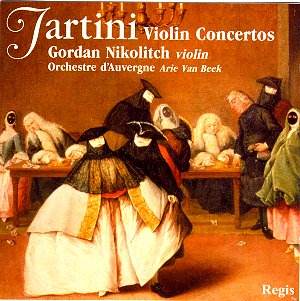It is not too long
ago that recordings of Tartini (with
the exception of the Devilís Trill sonata)
were as rare as Ďhenís teethĎ. This
issue is slowly being addressed as Tartini
recordings are now much more commonly
available on disc. For example at my
last count the period instrument ensemble
LíArte dellíArco, under director/violinist
Giovanni Guglielmo have now recorded
at least 14 volumes of Tartiniís works
for the Genoa-based Dynamic label.
I have read that of
the 200 or so known Tartini violin concertos
as many as 70 are thought to be missing.
However a small number of the lost concertos
were discovered recently in the Bibliothèque
Nationale, in Paris and have now been
recorded. The five concertos on this
Regis release give a good cross-section
of the concertos composed across Tartiniís
life. There is no reliable chronology
for Tartiniís compositions which is
a consistent problem although educated
guesses can often be broadly made with
reference to his compositional style.
In fact the musicologist Dounais has
catalogued Tartiniís music according
to their key. A number of works were
published in his lifetime but only a
relative small amount with his authorisation,
so the time-scale between composition
and publication remains unclear.
Tartiniís concertos
generally follow the established three
movement design Allegro-Andante-Allegro
popularised by Antonio Vivaldi.
The central slow movement is usually
presented in a contrasting key with
the outer movements being based on the
standard tutti-ritornello alternation,
occasionally interrupted by a substantial
solo passage.
It is fascinating to
see the progression of Tartiniís concerto-model
as he began to slowly develop the expressive
possibilities of his music in terms
of more sophisticated technique. He
returned later to a more austere conception
of structure but still displaying a
deepening of thought and an enrichment
of expression.
Tartini broke little
new ground in terms of innovation but
did make some reforms to the conventional
concerto form. For example in his Ďearly
periodí up to 1735 Tartini included
the use of cadenzas which he
referred to as a Capriccio section.
The more I hear Tartiniís
works the more I hold the view that
although he does not have Vivaldiís
innate gift for melody Tartiniís music
often has a deeper soul. Particularly
successful, as displayed on this Regis
release, are Tartiniís beautiful slow
movements that frequently plumb real
emotional depths and display a meditative
and intense passion, yet still maintain
grace and dignity.
It is with a feeling
of authentic ease that soloist Gordan
Nikolitch and the Orchestre díAuvergne
under Arie van Beek communicate these
delightful works with warmth and sensitivity.
Nikolitch is technically secure and
displays a clear and most agreeable
tone. His interpretations are attractive
and polished without ever being distinguished;
extremely acceptable nevertheless.
With regard to the
adequate sound quality, which is rather
warmish, I would have preferred a slightly
sharper focus. The booklet notes from
James Murray are concise yet interesting
and informative. The Regis label clearly
use previously released material for
their releases and can offer their ever
increasing catalogue at prices that
are frankly jaw-droppingly cheap. But
by cheap I donít mean cheap as in nasty
but cheap as in inexpensive. So donít
be put off by thinking that this recording
cannot be any good. The several Regis
releases that I have come across are
not only amazing value but offer very
acceptable performances in their own
right.
Michael Cookson
